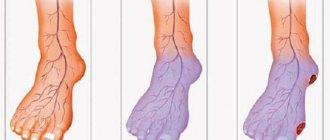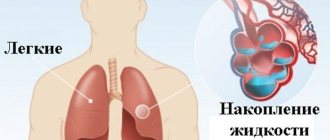Abdominal ischemia (mesenteric thrombosis, acute intestinal ischemia, intestinal circulatory failure) occurs when blood flow through the arteries that supply blood to the intestines slows or stops. This condition has many potential causes, including a clot blocking the artery or narrowing of the artery due to the development of cholesterol plaques. Blockages can also occur in veins, but they are less common.
Regardless of the cause, decreased blood flow to the gastrointestinal tract leaves tissues without sufficient oxygen, causing cell dysfunction and cell death. If the damage to the intestinal wall is severe enough, intestinal gangrene develops, followed by its rupture (perforation), resulting in fecal peritonitis and death.
Saving a person with mesenteric thrombosis is possible only with timely correct diagnosis, followed by removal of the blood clot and assessment of intestinal viability. With conventional symptomatic treatment, mortality reaches 99%, with surgery to remove the intestine - 80%, with timely removal of the blood clot and control of the intestine - 25%.
Treatment approach at the Innovative Vascular Center
Timely diagnosis of mesenteric ischemia allows for adequate treatment and saving a person’s life. In our clinic, if mesenteric ischemia is suspected, angiography is urgently performed and the blood clot is removed from the intestinal arteries. Only such treatment gives the patient a chance to survive. If enough time has passed since the onset of the disease, then restoration of blood circulation and laparoscopy are performed, which makes it possible to determine the need to remove dead sections of the intestine. Without treatment, all patients die. With treatment, more than half can be saved.
Prevention
Particular attention should be paid to patients who are in bed rest. A number of measures are used for this:
- regularly changing the patient's position;
- carrying out simple but active physical exercises;
- percussion massage on the chest;
- cupping massage;
- application of mustard plasters and compresses.
If the patient is in a weakened state, a balanced and vitamin-rich diet should be organized.
Causes of acute intestinal ischemia
- Atherosclerosis of the intestinal arteries can lead to their thrombosis with the subsequent development of mesenteric ischemia. If there are signs of coronary heart disease, atherosclerotic lesions of the arteries of the legs in a patient, systemic atherosclerosis can be implied and, accordingly, the risk of abdominal ischemia can be taken into account.
- High or low blood pressure increases the risk of mesenteric thrombosis and intestinal ischemia
- Heart failure and atrial fibrillation increase the risk of intestinal arterial embolism (transfer of a blood clot from the heart to the arteries) and acute intestinal ischemia.
- Increased blood clotting in thrombophilia, sickle cell anemia and antiphospholipid syndrome.
- Cocaine and methamphetamine use can cause intestinal vasospasm and intestinal ischemia.
Clinical forms of mesenteric thrombosis
- Vascular thrombosis of the colon (ischemic colitis)
This most common type of intestinal ischemia occurs when blood flow to the colon is reduced. It is most often observed in people over 60 years of age, although it can develop at any age. Signs and symptoms of colonic ischemia include bleeding from the anus and sudden cramping pain in the abdomen.
- Acute small bowel ischemia
This type of intestinal ischemia is usually associated with blockage of blood flow in the superior mesenteric artery. It has an abrupt onset. I am worried about severe abdominal pain, nausea, vomiting. The condition progressively worsens and the patient dies in the coming days.
- Chronic insufficiency of intestinal blood supply
Chronic abdominal (mesenteric) ischemia is sometimes called intestinal angina (angina pectoris). Develops as a result of the development of atherosclerotic plaques in the intestinal arteries. This process develops slowly, complaints are in the nature of digestive disorders, spasms in the intestines. A potentially dangerous complication of chronic mesenteric ischemia is the development of blood clots in the affected arteries, which block blood flow and cause acute abdominal ischemia.
- Venous abdominal ischemia
Develops with thrombosis of the mesenteric veins against the background of various diseases of the abdominal organs. When the intestinal veins are blocked, blood stagnates in the intestines, causing swelling of the intestines and bleeding of the mucous membrane. A complete block of venous outflow leads to the death of sections of the intestine with the development of peritonitis.
CONGISTENT PNEUMONIA IN THE ELDERLY – WHAT IS THIS DISEASE DANGEROUS?
Why does congestive pneumonia appear in the elderly?
- The development of stroke, heart attack, bronchopulmonary diseases, in which in the postoperative period the patient is deprived of the ability to move independently, inevitably leads to the development of congestive pneumonia;
- The older a person gets, the more his respiratory system becomes susceptible to functional changes: weakening of the diaphragm, shallow breathing (this is inevitable for people over 65 years of age), decreased elasticity of lung tissue;
- With age, pulmonary circulation becomes more difficult. Inactive bronchial ventilation leads to the fact that, one way or another, harmful and dangerous microorganisms (anaerobes, pneumococcus, enterobacteria) begin to rapidly multiply in the area of the bronchotracheal tree and oropharynx. Their active life activity leads to the development of congestive pneumonia.
CONGESTAL PNEUMONIA: SIGNS
Due to the fact that traditional pneumonia only affects small areas of lung tissue, drug treatment will be sufficient to treat it. The situation is much worse when it comes to congestive pneumonia, when fluid stagnates in the lungs and bronchi.
Attention! Elderly people may only suffer from weakness or lack of appetite, since other symptoms are often vague, so they may not even be aware of the presence of a dangerous disease.
Hypostatic pneumonia can be diagnosed by the following signs:
- The appearance of chills;
- The occurrence of drowsiness and weakness;
- Continuous cough;
- Increased sweating (the body loses its ability to thermoregulate);
- The occurrence of shortness of breath;
- Sudden changes in body temperature;
- Slight secretion of sputum during coughing;
- Audible wheezing.
Since this disease is insidious, it is very important to diagnose it in a timely manner.
CONGESTIVE PNEUMONIA: DIAGNOSTIC MEASURES IN ELDERLY PEOPLE
This disease does not have any special symptoms, so the main task of loved ones is to sound the alarm in time, and the main task of the attending physician of an elderly person is to diagnose the disease in time. Some previously suffered diseases, as well as diseases that have become chronic, can signal the possible development of hypostatic pneumonia, namely: stroke, heart attack, cardiosclerosis, heart disease, atherosclerosis, kidney inflammation, diabetes mellitus, asthmatic syndrome, pulmonary emphysema. To confirm the diagnosis, you need to resort to:
- X-ray examination. However, the image will be characterized by opacities that identify fluid in the lung. In this case, stagnant clots, characteristic, for example, of bronchopneumonia, are also visible in the image as clouding. In other words, congestive pneumonia can be confused with another disease, and not every medical institution is equipped with equipment for examining a bedridden patient;
- Ultrasound examination. By taking an ultrasound image and thus examining the pleural cavity, you can detect the exact location of the stagnant fluid;
- Steto- or phonendoscope - listening to the lungs. The presence of this disease will be confirmed by hoarse breathing and moist rales.
Localization of secondary pneumonia is the lower lobe of the right lung (the area farthest from the heart). If the doctor diagnoses this disease incorrectly, the elderly person may fall into a coma. Untimely or incorrect treatment also leads to urinary incontinence, depression, and sudden mood swings. This symptomatology is similar to cyanide dementia, so the doctor may make a mistake with the diagnosis.
Another cause of medical error may be the symptom of shortness of breath, since the doctor may regard it as a sign of heart failure. If the diagnosis was made incorrectly, and therefore the wrong treatment was prescribed, or the person consulted a doctor late, consequences may occur in the form of:
- Impaired blood outflow, which will inevitably lead to the pulmonary veins becoming overfilled;
- Leakage of blood plasma through the walls of blood vessels. The pulmonary alveoli begin to accumulate fluid, thus, pathogenic bacteria begin to develop;
The process of replacing lung tissue with connective tissue begins.
CONGISTENT PNEUMONIA: TREATMENT METHODS FOR ELDERLY PEOPLE
This disease requires hospital treatment and continuous monitoring by doctors. Since the disease is infectious, broad-spectrum antibiotics are required. In addition, it is necessary to restore normal ventilation of the lungs, which means that a diuretic, an expectorant, an antioxidant, and an immunomodulator will be prescribed.
In order to ease the work of the heart, the doctor will prescribe a glycoside and a drug to improve metabolism. To free the bronchi and trachea from sputum, it is necessary to prescribe bronchoscopy. If the pleural cavity is filled with fluid, a diuretic and puncture are necessary. This therapeutic complex will allow you to quickly stabilize the patient’s condition.
In addition, it is necessary to resort to physiotherapeutic methods: a course of massage, inhalations and oxygen masks. It is also useful to perform breathing exercises, especially the Buteyko and Strelnikova complex.
Be sure to perform a set of exercises that can normalize diaphragmatic breathing:
- Taking a lying position, fold your hands on your stomach and take a slow breath, then exhale through your mouth. At the same time, try to tense your abdominal muscles and press with your hands, creating a resistance effect in order to enhance exhalation;
- Taking a standing position, spreading your arms to the sides and spreading your legs wide, inhale. Then exhale slowly, move your arms forward, bend down, and at the same time make sure that your stomach is pulled in.
In order for sputum to be expelled more easily, it is necessary to carry out positional “drainage”, which consists in the fact that the body takes certain positions, so that the liquid flows into the area of reflexogenic zones, which causes a cough. It is necessary to take several deep breaths through the nose and exhale through the mouth, while the teeth should be clenched tightly, and then cough strongly. 30 minutes before the start of this complex, you need to drink a warm decoction: linden, plantain or coltsfoot, or just tea with honey or milk.
After being discharged home, it is necessary to continue treatment through traditional medicine.
CONGISTENT PNEUMONIA: TREATMENT WITH TRADITIONAL MEDICINE
Various decoctions help perfectly in the fight against this disease:
- Decoction of thyme or creeping thyme: 2 tbsp. spoons, brew one and a half liters of boiling water, then strain and take at least 4 times a day, ½ tbsp. before meals;
- Bearberry decoction: 1 tbsp. Brew a spoon with a glass of boiling water, divide into three parts and consume each of them 30 minutes after eating;
- Decoction of viburnum berries: 2 tbsp. Brew spoons with a glass of boiling water and leave overnight. Then add honey and take 2 tbsp. spoons after meals;
- A decoction of a collection of herbs: chamomile, St. John's wort, nettle, calendula, raspberry, marshmallow, elecampane, sage, plantain and calamus. It is necessary to mix all these herbs in 3 tbsp. spoons of each.
- Brew 2 tbsp. spoons of the collection with boiling water (0.5 l.), leave overnight, strain and take half a glass. The course of admission is about three months;
- The medicine “urbech”, whose homeland is Dagestan. Grind apricot kernels (3 kg) and flax seeds (3 kg), be sure to store the mixture in the refrigerator. When treatment is necessary, you need to take butter (1/2 pack), add 1 tbsp. spoon of the mixture and bring to a boil, then remove from heat, let cool and add 1 tbsp. a spoonful of honey. Then put it in the refrigerator and let it harden; if necessary, add it to the patient’s porridge or simply spread it on bread.
SURGICAL INTERVENTION FOR HYPOSTATIC PNEUMONIA
Most often, bedridden patients who cannot breathe need surgical intervention. In order to alleviate suffering, the doctor may prescribe a chest puncture. Thus, it becomes possible to “pump out” the fluid and free the lungs. The procedure is performed only in a hospital, by a qualified surgeon and under general anesthesia.
HYPOSTATIC PNEUMONIA IN ELDERLY PEOPLE: PREVENTIVE MEASURES
As you know, it is better to prevent the development of any disease than to treat it later. Since hypostatic pneumonia is a complication of another disease, older people need to take care and follow the following rules:
- Always ensure that your feet are dry and warm;
- Practice daily walks in the fresh air;
- Take time for proper daily rest;
- To refuse from bad habits;
- Pay attention to proper and nutritious nutrition;
- Allergy sufferers should especially monitor the condition of their disease;
It is mandatory to undergo the vaccination procedure in order to prevent the development of influenza during its epidemic.
If we are talking about a bedridden elderly person, then relatives need to prevent the development of congestive pneumonia: turn the patient over more often, massage his chest, use cups and mustard plasters, perform the previously described physical exercises with him, make sure that the room in which the person is lying , it was well ventilated and the air was humidified.
Modern medicine makes it possible to treat hypostatic pneumonia in older people without any problems, only if they timely seek qualified medical help and correct diagnosis. At the same time, the desire of the patient himself and his efforts during therapeutic exercises are also important, so relatives need to adjust the patient accordingly. And after treatment, it is important for an elderly person to lead a healthy and active lifestyle.
Complications of mesenteric thrombosis
- Gangrene of the intestine. If the blood flow to the intestines is completely blocked, then its death develops.
- Perforation. The dead section of intestine may rupture. As a result, the contents of the intestines spill into the abdominal cavity, causing an infectious process in the peritoneum (peritonitis).
- Scar changes in the intestinal wall. Sometimes these dangerous complications do not develop, but the damaged intestinal wall is replaced by a scar, causing narrowing of the intestinal tube and the development of intestinal obstruction.










